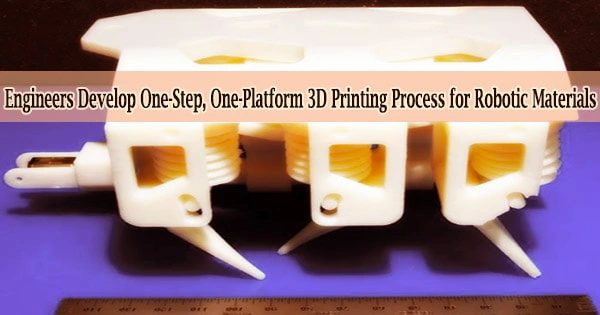In order to construct robots in a single step, a team of UCLA engineers and their colleagues have created a novel design methodology and 3D printing technology.
A paper that described the development, as well as the creation and presentation of a variety of little robots that can walk, move, and leap, was published in Science.
The innovation allowed a new form of 3D printing procedure for designed active materials with many functions to enable the complete mechanical and electronic systems required to run a robot to be built all at once (also known as metamaterials). A “meta-bot” that has been 3D printed can move, sense its environment, and make decisions.
The internal network of sensing, movement, and structural components in printed metamaterials allows them to move autonomously in response to pre-programmed commands. The only external component required is a small battery to power the robot since it already has an internal network for moving and sensing.
“We envision that this design and printing methodology of smart robotic materials will help realize a class of autonomous materials that could replace the current complex assembly process for making a robot,” said the study’s principal investigator Xiaoyu (Rayne) Zheng, an associate professor of civil and environmental engineering, and of mechanical and aerospace engineering at the UCLA Samueli School of Engineering.
“With complex motions, multiple modes of sensing, and programmable decision-making abilities all tightly integrated, it’s similar to a biological system with the nerves, bones, and tendons working in tandem to execute controlled motions.”
The team showed how to integrate a controller and on-board batteries to enable fully autonomous functioning of the fingernail-sized 3D printed robots.
The methodology, according to Zheng, a member of the California NanoSystems Institute at UCLA, could result in new designs for biomedical robots, such as self-steering endoscopes or tiny swimming robots that can emit ultrasounds and navigate themselves close to blood vessels to deliver drug doses at particular target sites inside the body.
This allows actuating elements to be arranged precisely throughout the robot for fast, complex, and extended movements on various types of terrain. With the two-way piezoelectric effect, the robotic materials can also self-sense their contortions, detect obstacles via echoes and ultrasound emissions, as well as respond to external stimuli through a feedback control loop that determines how the robots move, and how fast they move, and toward which target they move.
Huachen Cui
Also capable of exploring dangerous situations are these “meta-bots.” A swarm of these tiny robots, equipped with integrated sensing components, could easily explore limited locations in a collapsed structure, assess the threat level, and aid with rescue operations by locating persons who were buried under the wreckage.
Regardless of size, the majority of robots are normally constructed via a number of intricate manufacturing procedures that incorporate limbs, electronics, and active parts. Compared to robots that may be constructed utilizing this new technique, the procedure yields greater weights, bulkier volumes, and lower force output.
The piezoelectric metamaterials, a family of complex lattice materials that can change shape and move in reaction to an electric field or create electrical charge as a result of physical forces, were designed and printed as the key component of the UCLA-led, all-in-one technique.
Active materials that can convert electricity into motion have long been used. However, the range of motion and travel distance of these materials are typically constrained. In order to produce the appropriate motions, they also require connections to transmission systems that resemble gearboxes.
In contrast, the complicated piezoelectric and structural components of the penny-sized robotic materials created by UCLA are intended to bend, flex, twist, spin, expand, or compress quickly.
In order for users to create their own models and print the materials into robots, the team also developed a framework for designing these robotic materials.
“This allows actuating elements to be arranged precisely throughout the robot for fast, complex, and extended movements on various types of terrain,” said the study’s lead author Huachen Cui, a UCLA postdoctoral scholar in Zheng’s Additive Manufacturing and Metamaterials Laboratory.
“With the two-way piezoelectric effect, the robotic materials can also self-sense their contortions, detect obstacles via echoes and ultrasound emissions, as well as respond to external stimuli through a feedback control loop that determines how the robots move, how fast they move, and toward which target they move.”
The team created and displayed three “meta-bots” with various capacities using this method. One robot can maneuver around random obstacles and S-shaped corners, another may flee in the event of contact, while a third can walk over uneven terrain and even make short jumps.
Graduate students Desheng Yao, Ryan Hensleigh, Zhenpeng Xu, and Haotian Lu from UCLA, as well as postdoctoral researcher Ariel Calderon and development engineering associate Zhen Wang, are additional authors on the work.
Patrick Mercier, an associate professor of electrical and computer engineering at UC San Diego, Sheyda Davaria, a research associate at Virginia Tech, and Pablo Tarazaga, a professor of mechanical engineering at Texas A&M University, are other writers.
The U.S. Office of Naval Research, the Air Force Office of Scientific Research, and the National Science Foundation all provided extra funding for the study in addition to the Defense Advanced Research Projects Agency’s (DARPA) Young Faculty Award and Director’s Fellowship Award.
The improvement makes use of 3D printing technologies that Zheng and Hensleigh had created while working as researchers at Virginia Tech, the owner of the patent. For the novel UCLA-developed methodology, the researchers want to submit an additional patent application through the UCLA Technology Development Group.





